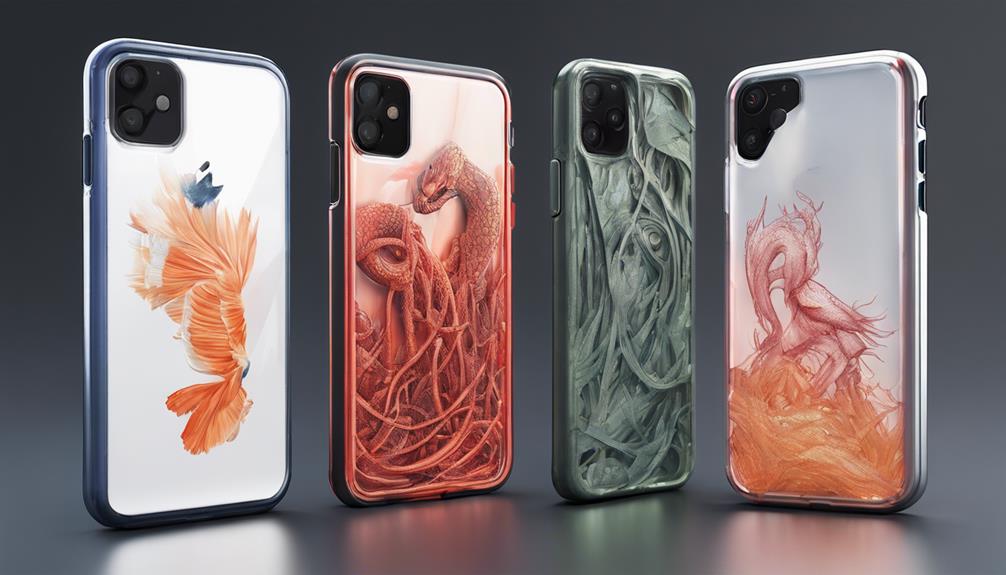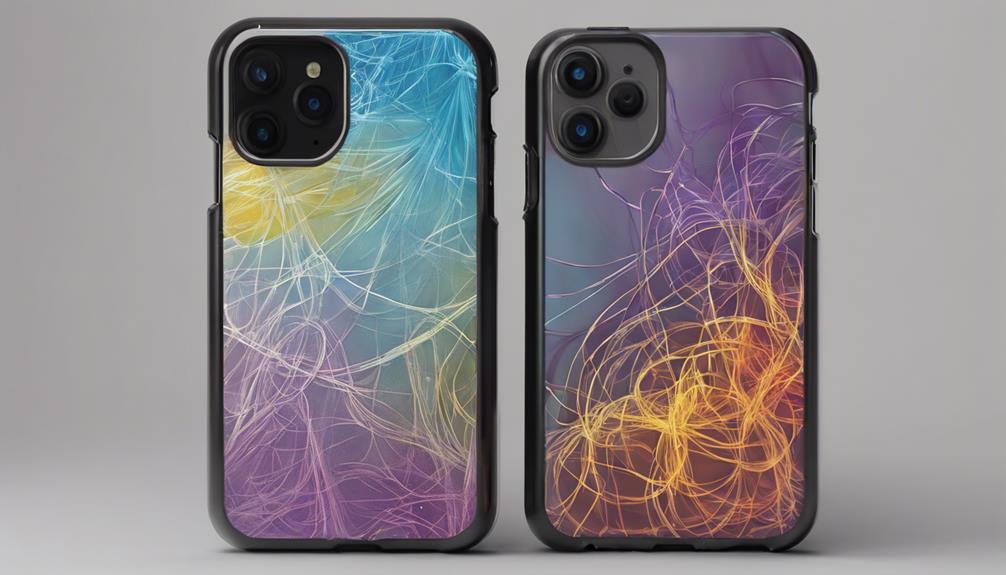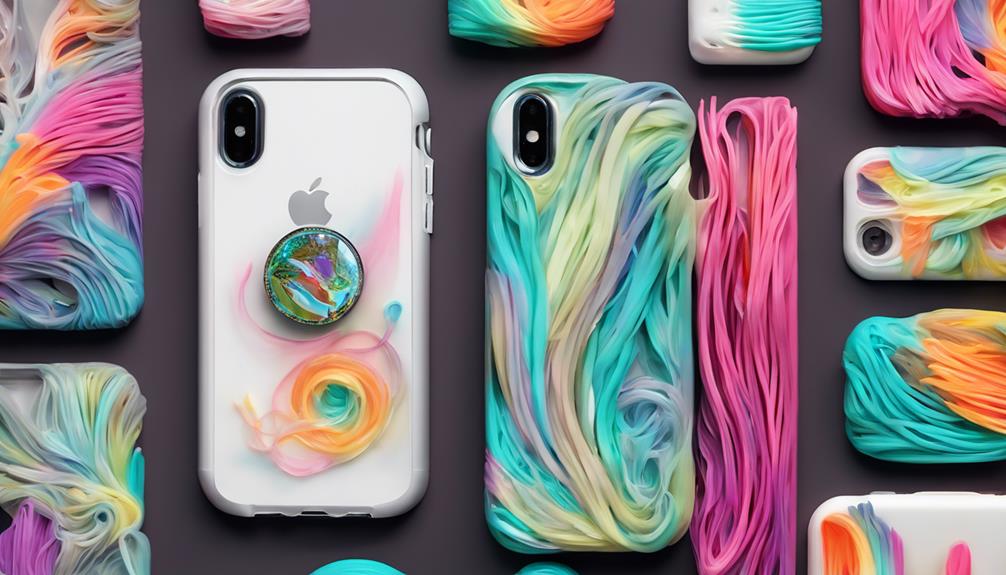Careful consideration of filament choice can have a major impact on the quality and functionality of 3D printed phone cases. With a plethora of options available, it is crucial to pinpoint the top filaments that can elevate your prints to the next level. These filaments not only enhance the durability and flexibility of your phone case but also guarantee reliable protection for your device. By understanding the unique properties and benefits of each recommended filament, you can make informed decisions to optimize your phone case prints for superior performance and longevity.
Impact Performance and Material Characteristics

Impact performance and material characteristics play a crucial role in determining the effectiveness of phone cases in mitigating damage from impacts. Phone case performance hinges on energy absorption and distribution.
Hard cases tend to transmit more energy to the device as they lack deformation capabilities, while soft TPU cases deform under pressure, effectively transferring impact. Hybrid cases, typically made from Nylon, offer a balance of rigidity and flexibility.
TPU, with a shore A hardness of 95A, is commonly used due to its rubber-like properties. TPE, though more flexible than TPU, presents challenges in printing. Nylon stands out for its high impact resistance and flexibility, capable of withstanding higher temperatures compared to PLA without deforming.
Flexible Filaments for Phone Cases
What distinguishes flexible filaments as ideal choices for phone case manufacturing?
Flexible filaments, such as TPU (Thermoplastic Polyurethane), are commonly used in the production of phone cases due to their shock absorption capabilities. Materials like Flexfill 98A, NinjaFlex, MatterHackers PRO Series TPU, and Cheetah TPU are popular options known for their springiness and toughness.
These flexible filaments allow phone cases to deform under pressure, effectively absorbing and distributing impact energy. By providing a cushioning effect, TPU-based filaments help protect devices from damage during accidental drops or impacts.
Their flexibility also enables a snug fit and easy installation on various phone models, making them a preferred choice for 3D printing phone cases that prioritize impact resistance and user convenience.
Rigid Filaments for Phone Cases

Stiff filaments play an essential role in enhancing the structural integrity and impact resistance of phone cases. When it comes to rigid filaments for phone case printing, materials like Nylon, PETG, and ABS stand out.
Nylon, known for high impact resistance and flexibility to absorb shocks, distributes force evenly during impacts. PETG, a strong alternative to PLA, offers durability and toughness, with options like MatterHackers PRO Series PETG and Overture PETG providing enhanced printing ease. ABS, providing structural rigidity and impact resistance, excels in impact strength and wear resistance, making it a reliable choice for phone cases.
While PLA is commonly used, it is prone to deformation and brittleness, emphasizing the importance of selecting the right rigid filament for the best phone case performance.
Alternative Filaments and Material Comparisons
When exploring alternative filaments and comparing materials for 3D printing phone cases, it is imperative to take into account the unique properties and characteristics of each option.
- Soft PLA:
- Slightly softer than TPU.
- Compatible with standard PLA printers.
- Offers less protection due to brittleness.
- Soft PLA vs. TPU:
- Soft PLA can be an alternative to TPU for phone case printing.
- Soft PLA cases may not provide the same level of impact resistance as TPU.
- Considerations:
- Evaluate the level of protection needed.
- Assess the printing capabilities of your 3D printer.
- Balance material characteristics with the desired phone case functionality.
Resources and Recommendations for 3D Printing Phone Cases

As the exploration of alternative filaments and material comparisons for 3D printing phone cases wraps up, moving on to the discussion on resources and recommendations is essential for informed decision-making in this field.
When seeking resources for 3D printing phone cases, platforms like Thingiverse, MyMiniFactory, Cults3D, and GrabCAD offer a wide array of downloadable 3D-printable designs to choose from.
Additionally, selected 3D printers, filaments, and upgrades are recommended for all user levels to streamline the decision-making process. These recommended products have been tested and chosen based on their performance, aiming to simplify the journey for users looking to create high-quality and durable phone cases through 3D printing.
Frequently Asked Questions
Can I Mix Different Filaments to Create a Custom Phone Case Material?
Mixing different filaments to create a custom phone case material is not recommended due to varying material properties, potentially compromising impact resistance and structural integrity. It is advised to choose a single filament type best suited for the desired phone case characteristics.
Are There Any Eco-Friendly Filament Options for Sustainable Phone Case Printing?
"Exploring sustainable 3D printing options for phone cases, eco-friendly filaments like PLA, PETG, and bio-based materials offer environmentally conscious choices. These filaments balance performance and sustainability, contributing to greener manufacturing practices."
How Can I Add Personalized Designs or Textures to My 3d-Printed Phone Case?
To add personalized designs or textures to 3D-printed phone cases, utilize software like Tinkercad or Fusion 360 for modeling. Incorporate logos, patterns, or embossed textures. Experiment with filaments like PLA, PETG, or TPU to enhance aesthetics and functionality.
What Post-Processing Techniques Can Enhance the Durability of 3d-Printed Phone Cases?
Post-processing techniques like acetone vapor smoothing for ABS, sanding for PLA, and applying epoxy coatings can enhance the durability of 3D-printed phone cases. These methods improve surface finish, strength, and resistance to wear and impact, ensuring longevity.
Are There Any Safety Considerations When Choosing Filaments for Phone Case Printing?
Safety considerations when choosing filaments for phone case printing include selecting materials with appropriate shore hardness, impact resistance, and deformation properties. For instance, TPU with 95A shore hardness offers flexibility and shock absorption, enhancing phone protection.
Conclusion
To wrap up, selecting the right filament for your 3D printed phone cases is crucial for enhancing their performance and durability.
Flexible filaments like TPU and NinjaFlex offer superior impact resistance and flexibility, while rigid filaments provide added strength and stability.
By choosing high-quality materials, you can guarantee excellent protection for your device.
Remember, the filament you choose is like the foundation of a sturdy house – it sets the tone for the overall strength and resilience of your phone case prints.